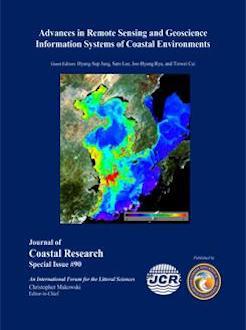Mu, B.; Qin, P.; Liu, C.; Liang, X.-J., and Huang, T.-X., 2019. An assessment of atmospheric correction methods for GOCI images in the Yellow River Estuary. In: Jung, H.-S.; Lee, S.; Ryu, J.-H., and Cui, T. (eds.), Advances in Remote Sensing and Geoscience Information Systems of Coastal Environments. Journal of Coastal Research, Special Issue No. 90, pp. 171-182. Coconut Creek (Florida), ISSN 0749-0208.
The Yellow River Estuary is a typical case II water body with high turbidity. Atmospheric correction of Geostationary Ocean Color Imager (GOCI) data is difficult in such areas. The applicability of existing atmospheric correction methods suffers from a lack of systematic assessment. In this study, the nearest-neighbor, near-infrared (NIR)-ratio, and ultraviolet atmospheric correction (UV-AC) techniques are applied to GOCI images of the Yellow River Estuary, and the quality of the water-leaving reflectance ρw(λ) obtained by these methods is evaluated. The results show that the performance of the NIR-ratio and UV-AC methods is almost the same compared with in situ synchronous data, with the absolute percentage difference (APD) of each band ranging from 6–48 % and 9–47 %, respectively. The accuracy of the 660 nm and 680 nm bands is the highest (APD less than 10 %). The values of ρw(λ) retrieved by the nearest-neighbor method are obviously underestimated, with an APD ranging from 30–196 %. Moreover, negative values appear in the NIR and blue bands. A rationality evaluation of the spectral shape of ρw(λ) extracted from the GOCI images further confirms the consistency of the results obtained by the UV-AC and NIR-ratio methods. Approximately 86 % of pixels were scored the same by the two methods. Based on the above evaluation results, the NIR-ratio and UV-AC methods are concluded to have the same accuracy, and both perform better than the nearest-neighbor method. The input parameters of the NIR-ratio method are determined in advance using in situ measured data. On account of the limited amount of measured data, the representativeness and applicability of the input parameters are yet to be confirmed.





